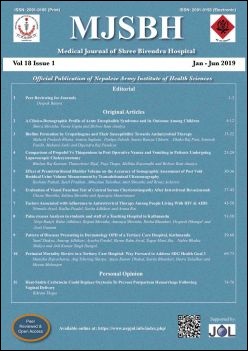Evaluation of Visual Function Test of Central Serous Chorioretinopathy After Intravitreal Bevacizumab
Keywords:
Bevacizumab, Central serous chorioretinopathy, Fundus fluorescein angiography, Optical coherence TomographyAbstract
Introduction: Central Serous Chorioretinopathy (CSCR) is a condition of unknown origin characterised by a serous detachment of the macula, affecting young healthy adults mostly men between the age of 20- 50 years. It is postulated to occur secondary to a leak from the choriocapillaries through the Retinal Pigment Epithelium (RPE). This study was carried out to evaluate the visual function test of CSCR after intravitreal Bevacizumab.
Methods: This is a hospital based, prospective, interventional, non-comparative study conducted in a tertiary level eye hospital in Nepal from 2016 January to 2017 January. The study included 15 eyes of 15 patients with chronic CSCR, All patients were injected with intravitreal Avastin (IVA) 1.25 mg (0.05 mL). At baseline and follow up visits, patients had contrast sensitivity, stereopsis, colour vision, BCVA, IOP assessment, FFA, dilated fundus examination, and OCT imaging was used for measurement of central macular thickness.
Results: The mean age of patients was 35 years (26–47 years), 12 (80%) patients were males and three (20%) were females. 13 out of 15 subjects received one injection while the remaining two cases had two injections. All eyes had gained two or more lines improvement in BCVA at the end of follow up. The mean baseline CRT for all patients was 533 ±79.5 lm (range, 412–677), decreased to 253± 39.2 lm (range, 192–343) after three months with statistically significant (p <0.001 Wilcoxon sign rank test). Contrast sensitivity by Wilcoxon sign rank test was statistically significant with p value 0.003.
Conclusions: Bevacizumab was associated with visual function improvement and reduced neurosensory detachment without adverse events in patients with CSCR.
Downloads
Downloads
Published
How to Cite
Issue
Section
License
This license enables reusers to distribute, remix, adapt, and build upon the material in any medium or format for noncommercial purposes only, and only so long as attribution is given to the creator.




